Project Management Assignment: Project Leadership and Management
VerifiedAdded on 2021/05/30
|22
|3821
|54
Project
AI Summary
This project management assignment delves into various aspects of project execution and leadership. The first question focuses on the negotiation process between functional managers and team members, outlining the phases involved and emphasizing the importance of aligning roles and responsibilities with project objectives. The second question analyzes different categories of project risks, including operational, technical, legal, and communication risks, along with mitigation strategies. It also examines how a project manager's decision-making can be influenced by risks associated with project charter approval, financial funding, and requirement specifications. The third question categorizes different project types such as technical, research, social, and organizational projects and discusses the importance of the statement of work (SOW) in defining project activities, deliverables, and associated costs, using a case study of a company facing legal issues due to misinterpreting an SOW. The fourth question differentiates between leadership and management, highlighting their roles in synchronizing work schedules, motivating employees, and guiding project completion. It also explores the qualities of an effective project manager and the importance of communication and employee empowerment.
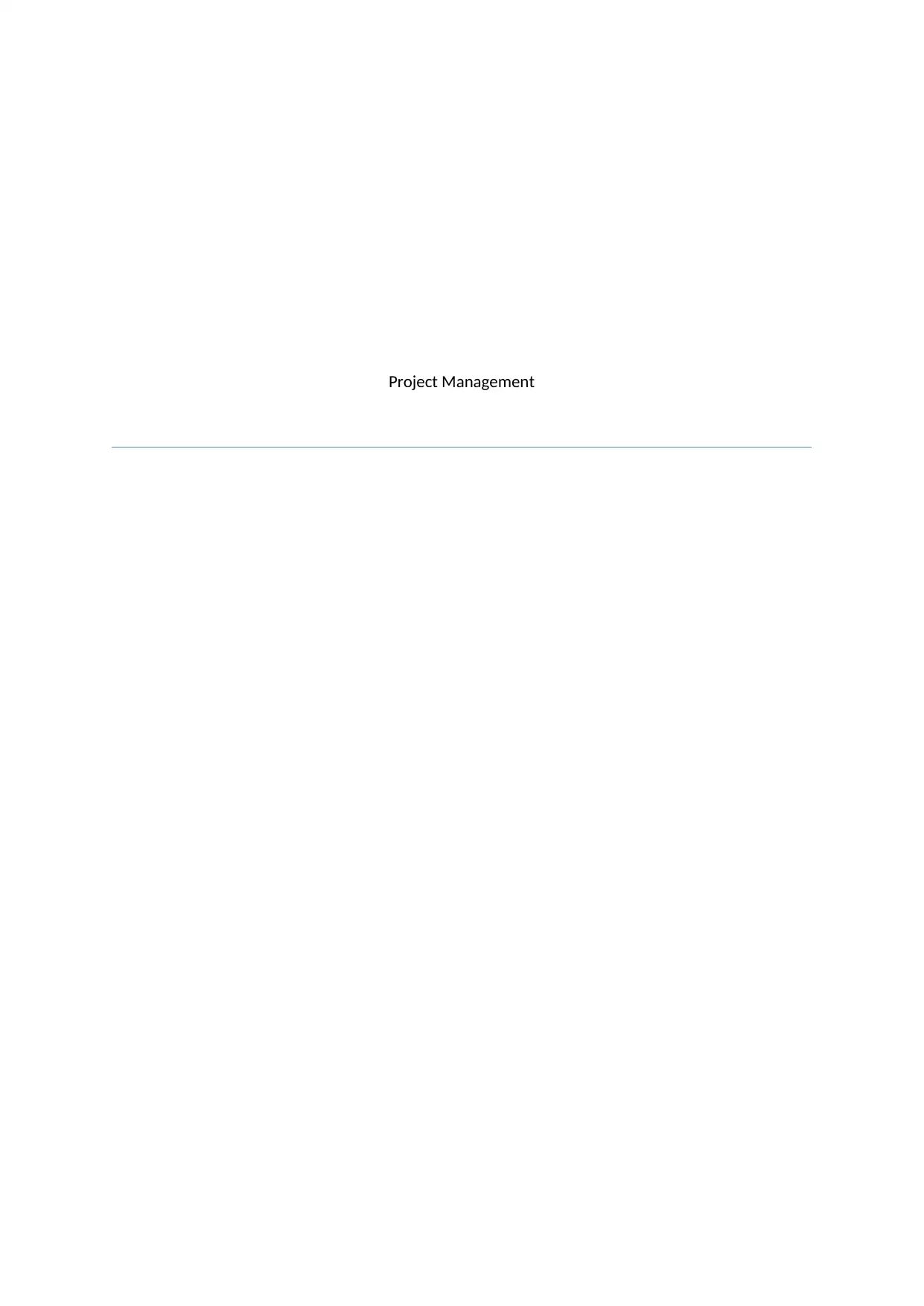
Project Management
Paraphrase This Document
Need a fresh take? Get an instant paraphrase of this document with our AI Paraphraser
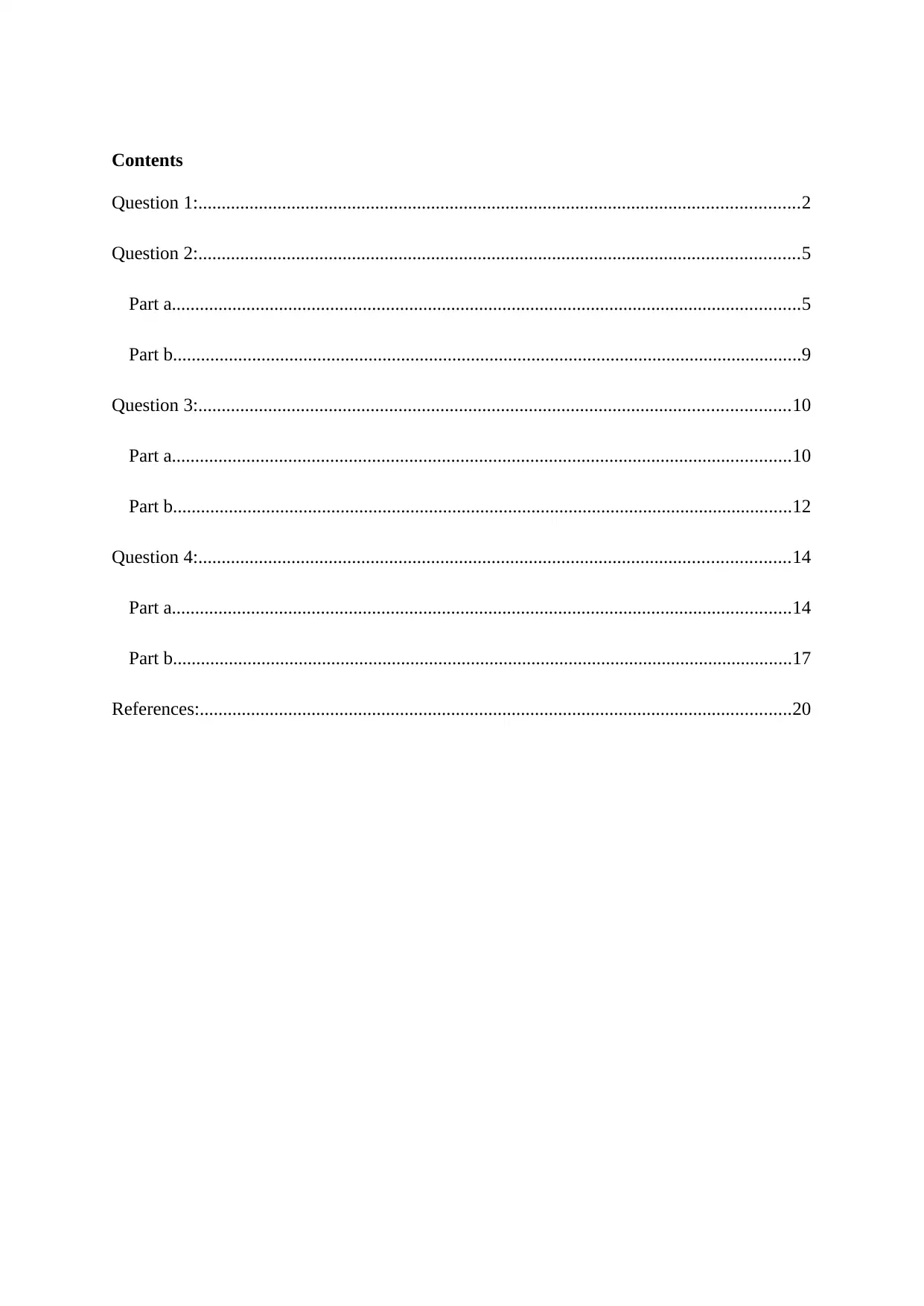
Contents
Question 1:.................................................................................................................................2
Question 2:.................................................................................................................................5
Part a.......................................................................................................................................5
Part b.......................................................................................................................................9
Question 3:...............................................................................................................................10
Part a.....................................................................................................................................10
Part b.....................................................................................................................................12
Question 4:...............................................................................................................................14
Part a.....................................................................................................................................14
Part b.....................................................................................................................................17
References:...............................................................................................................................20
Question 1:.................................................................................................................................2
Question 2:.................................................................................................................................5
Part a.......................................................................................................................................5
Part b.......................................................................................................................................9
Question 3:...............................................................................................................................10
Part a.....................................................................................................................................10
Part b.....................................................................................................................................12
Question 4:...............................................................................................................................14
Part a.....................................................................................................................................14
Part b.....................................................................................................................................17
References:...............................................................................................................................20
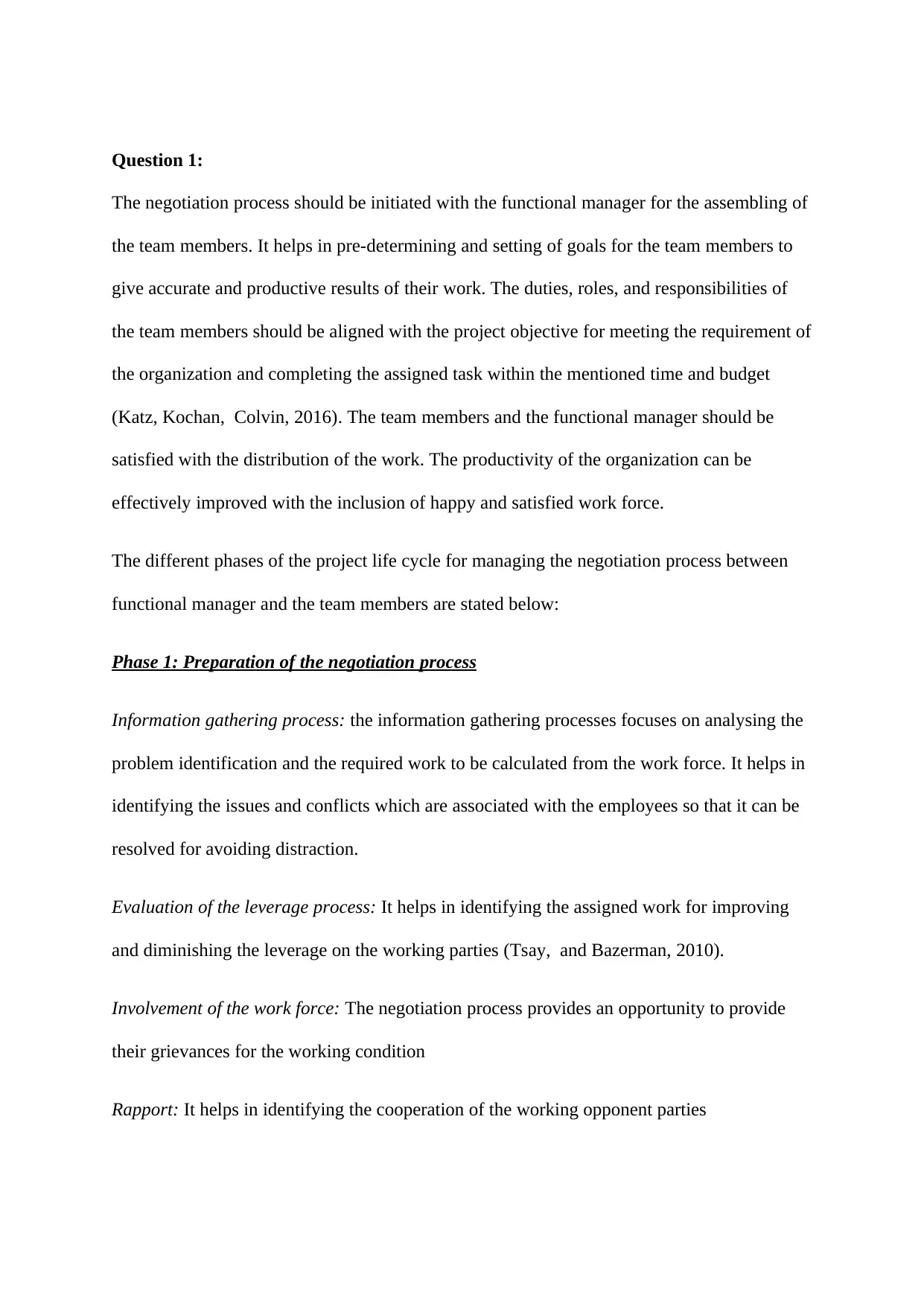
Question 1:
The negotiation process should be initiated with the functional manager for the assembling of
the team members. It helps in pre-determining and setting of goals for the team members to
give accurate and productive results of their work. The duties, roles, and responsibilities of
the team members should be aligned with the project objective for meeting the requirement of
the organization and completing the assigned task within the mentioned time and budget
(Katz, Kochan, Colvin, 2016). The team members and the functional manager should be
satisfied with the distribution of the work. The productivity of the organization can be
effectively improved with the inclusion of happy and satisfied work force.
The different phases of the project life cycle for managing the negotiation process between
functional manager and the team members are stated below:
Phase 1: Preparation of the negotiation process
Information gathering process: the information gathering processes focuses on analysing the
problem identification and the required work to be calculated from the work force. It helps in
identifying the issues and conflicts which are associated with the employees so that it can be
resolved for avoiding distraction.
Evaluation of the leverage process: It helps in identifying the assigned work for improving
and diminishing the leverage on the working parties (Tsay, and Bazerman, 2010).
Involvement of the work force: The negotiation process provides an opportunity to provide
their grievances for the working condition
Rapport: It helps in identifying the cooperation of the working opponent parties
The negotiation process should be initiated with the functional manager for the assembling of
the team members. It helps in pre-determining and setting of goals for the team members to
give accurate and productive results of their work. The duties, roles, and responsibilities of
the team members should be aligned with the project objective for meeting the requirement of
the organization and completing the assigned task within the mentioned time and budget
(Katz, Kochan, Colvin, 2016). The team members and the functional manager should be
satisfied with the distribution of the work. The productivity of the organization can be
effectively improved with the inclusion of happy and satisfied work force.
The different phases of the project life cycle for managing the negotiation process between
functional manager and the team members are stated below:
Phase 1: Preparation of the negotiation process
Information gathering process: the information gathering processes focuses on analysing the
problem identification and the required work to be calculated from the work force. It helps in
identifying the issues and conflicts which are associated with the employees so that it can be
resolved for avoiding distraction.
Evaluation of the leverage process: It helps in identifying the assigned work for improving
and diminishing the leverage on the working parties (Tsay, and Bazerman, 2010).
Involvement of the work force: The negotiation process provides an opportunity to provide
their grievances for the working condition
Rapport: It helps in identifying the cooperation of the working opponent parties
⊘ This is a preview!⊘
Do you want full access?
Subscribe today to unlock all pages.

Trusted by 1+ million students worldwide
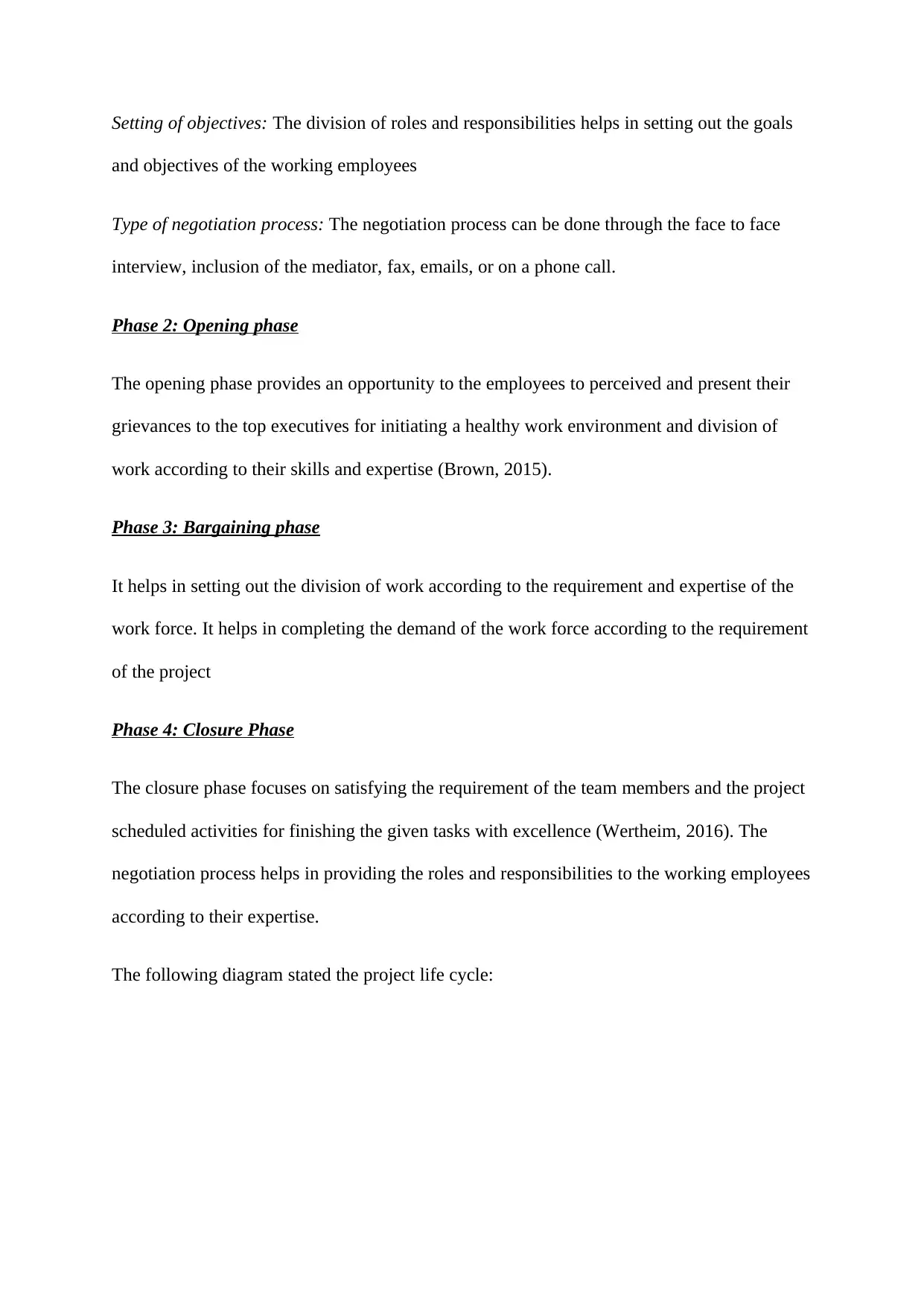
Setting of objectives: The division of roles and responsibilities helps in setting out the goals
and objectives of the working employees
Type of negotiation process: The negotiation process can be done through the face to face
interview, inclusion of the mediator, fax, emails, or on a phone call.
Phase 2: Opening phase
The opening phase provides an opportunity to the employees to perceived and present their
grievances to the top executives for initiating a healthy work environment and division of
work according to their skills and expertise (Brown, 2015).
Phase 3: Bargaining phase
It helps in setting out the division of work according to the requirement and expertise of the
work force. It helps in completing the demand of the work force according to the requirement
of the project
Phase 4: Closure Phase
The closure phase focuses on satisfying the requirement of the team members and the project
scheduled activities for finishing the given tasks with excellence (Wertheim, 2016). The
negotiation process helps in providing the roles and responsibilities to the working employees
according to their expertise.
The following diagram stated the project life cycle:
and objectives of the working employees
Type of negotiation process: The negotiation process can be done through the face to face
interview, inclusion of the mediator, fax, emails, or on a phone call.
Phase 2: Opening phase
The opening phase provides an opportunity to the employees to perceived and present their
grievances to the top executives for initiating a healthy work environment and division of
work according to their skills and expertise (Brown, 2015).
Phase 3: Bargaining phase
It helps in setting out the division of work according to the requirement and expertise of the
work force. It helps in completing the demand of the work force according to the requirement
of the project
Phase 4: Closure Phase
The closure phase focuses on satisfying the requirement of the team members and the project
scheduled activities for finishing the given tasks with excellence (Wertheim, 2016). The
negotiation process helps in providing the roles and responsibilities to the working employees
according to their expertise.
The following diagram stated the project life cycle:
Paraphrase This Document
Need a fresh take? Get an instant paraphrase of this document with our AI Paraphraser
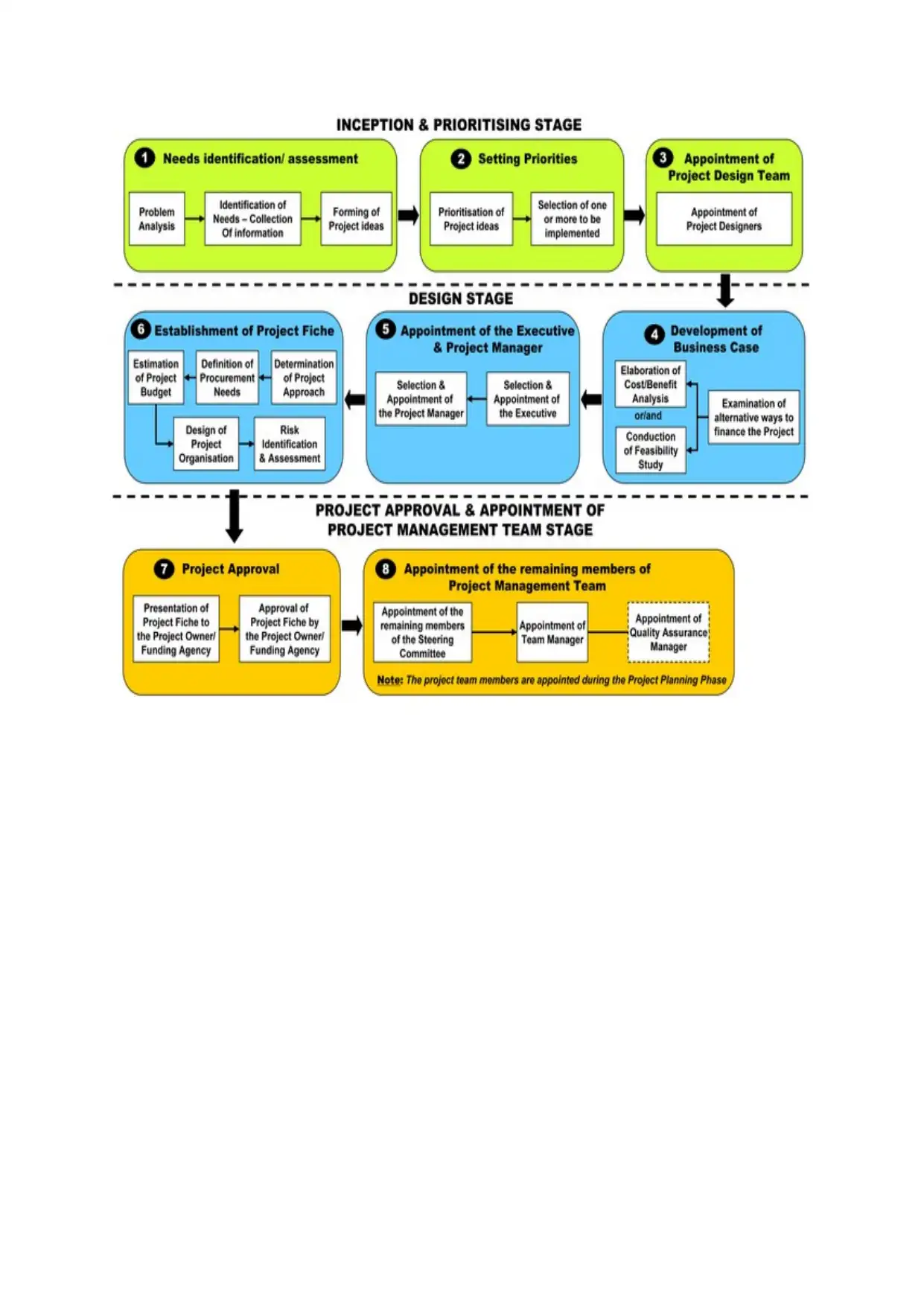
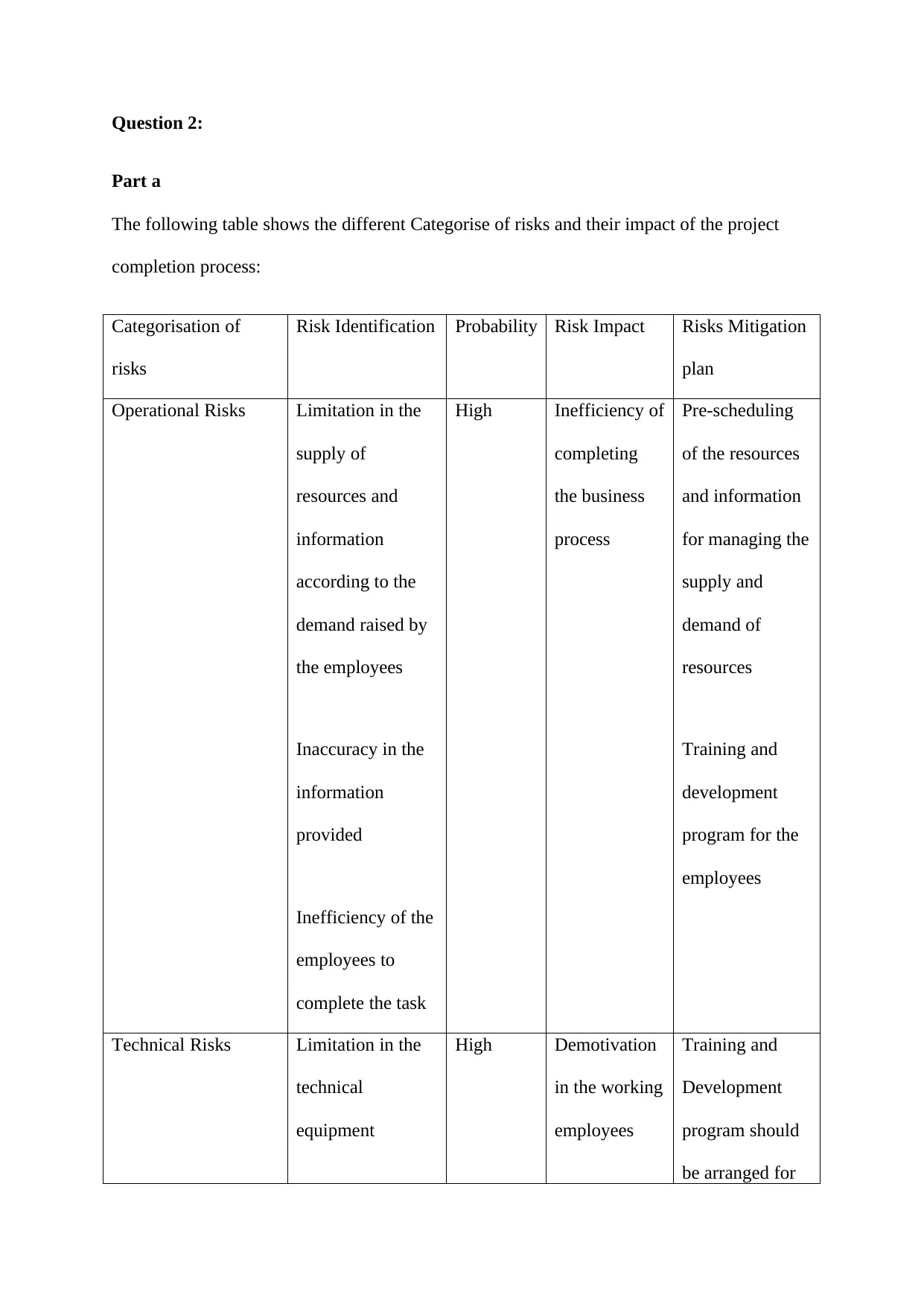
Question 2:
Part a
The following table shows the different Categorise of risks and their impact of the project
completion process:
Categorisation of
risks
Risk Identification Probability Risk Impact Risks Mitigation
plan
Operational Risks Limitation in the
supply of
resources and
information
according to the
demand raised by
the employees
Inaccuracy in the
information
provided
Inefficiency of the
employees to
complete the task
High Inefficiency of
completing
the business
process
Pre-scheduling
of the resources
and information
for managing the
supply and
demand of
resources
Training and
development
program for the
employees
Technical Risks Limitation in the
technical
equipment
High Demotivation
in the working
employees
Training and
Development
program should
be arranged for
Part a
The following table shows the different Categorise of risks and their impact of the project
completion process:
Categorisation of
risks
Risk Identification Probability Risk Impact Risks Mitigation
plan
Operational Risks Limitation in the
supply of
resources and
information
according to the
demand raised by
the employees
Inaccuracy in the
information
provided
Inefficiency of the
employees to
complete the task
High Inefficiency of
completing
the business
process
Pre-scheduling
of the resources
and information
for managing the
supply and
demand of
resources
Training and
development
program for the
employees
Technical Risks Limitation in the
technical
equipment
High Demotivation
in the working
employees
Training and
Development
program should
be arranged for
⊘ This is a preview!⊘
Do you want full access?
Subscribe today to unlock all pages.

Trusted by 1+ million students worldwide
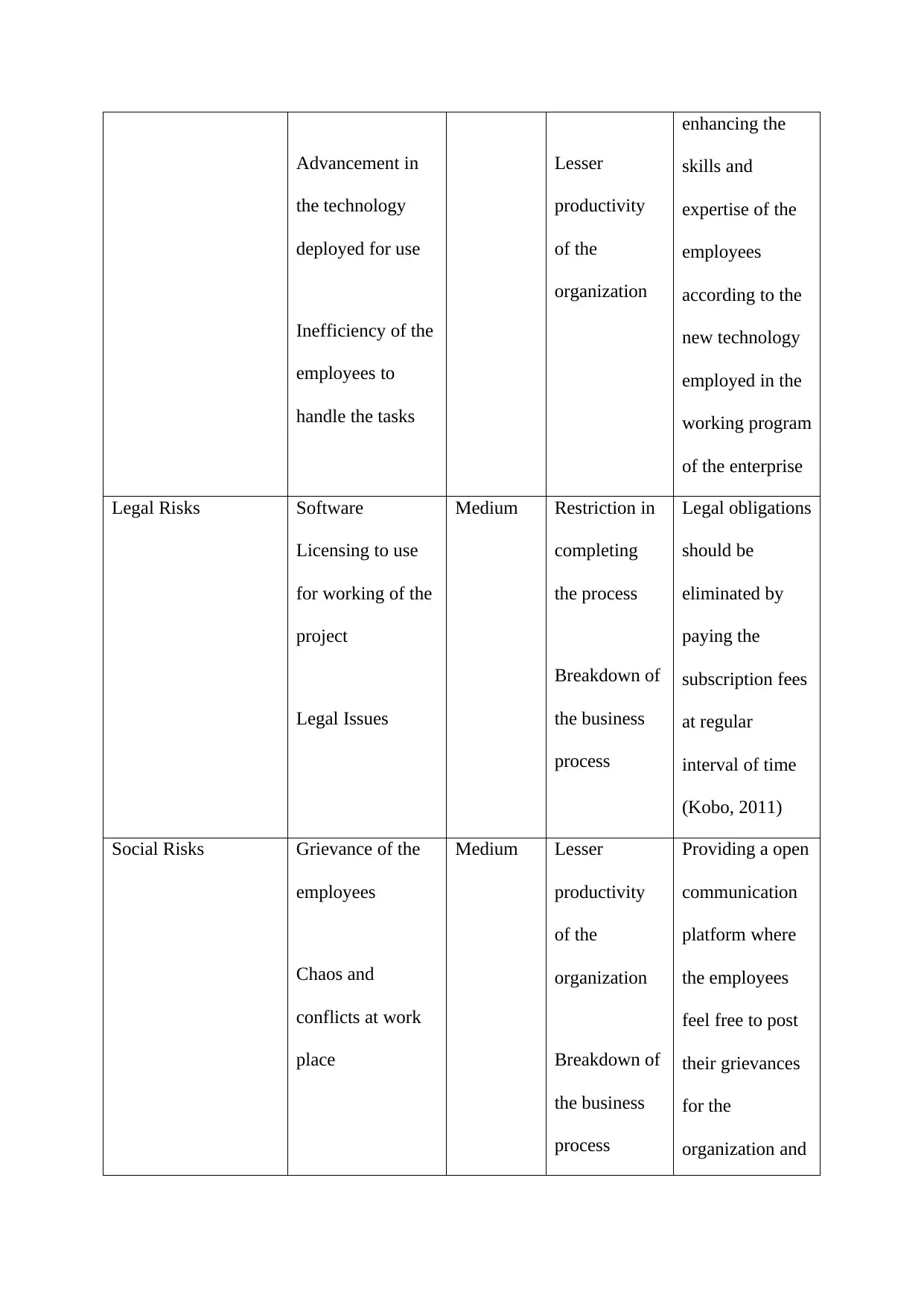
Advancement in
the technology
deployed for use
Inefficiency of the
employees to
handle the tasks
Lesser
productivity
of the
organization
enhancing the
skills and
expertise of the
employees
according to the
new technology
employed in the
working program
of the enterprise
Legal Risks Software
Licensing to use
for working of the
project
Legal Issues
Medium Restriction in
completing
the process
Breakdown of
the business
process
Legal obligations
should be
eliminated by
paying the
subscription fees
at regular
interval of time
(Kobo, 2011)
Social Risks Grievance of the
employees
Chaos and
conflicts at work
place
Medium Lesser
productivity
of the
organization
Breakdown of
the business
process
Providing a open
communication
platform where
the employees
feel free to post
their grievances
for the
organization and
the technology
deployed for use
Inefficiency of the
employees to
handle the tasks
Lesser
productivity
of the
organization
enhancing the
skills and
expertise of the
employees
according to the
new technology
employed in the
working program
of the enterprise
Legal Risks Software
Licensing to use
for working of the
project
Legal Issues
Medium Restriction in
completing
the process
Breakdown of
the business
process
Legal obligations
should be
eliminated by
paying the
subscription fees
at regular
interval of time
(Kobo, 2011)
Social Risks Grievance of the
employees
Chaos and
conflicts at work
place
Medium Lesser
productivity
of the
organization
Breakdown of
the business
process
Providing a open
communication
platform where
the employees
feel free to post
their grievances
for the
organization and
Paraphrase This Document
Need a fresh take? Get an instant paraphrase of this document with our AI Paraphraser
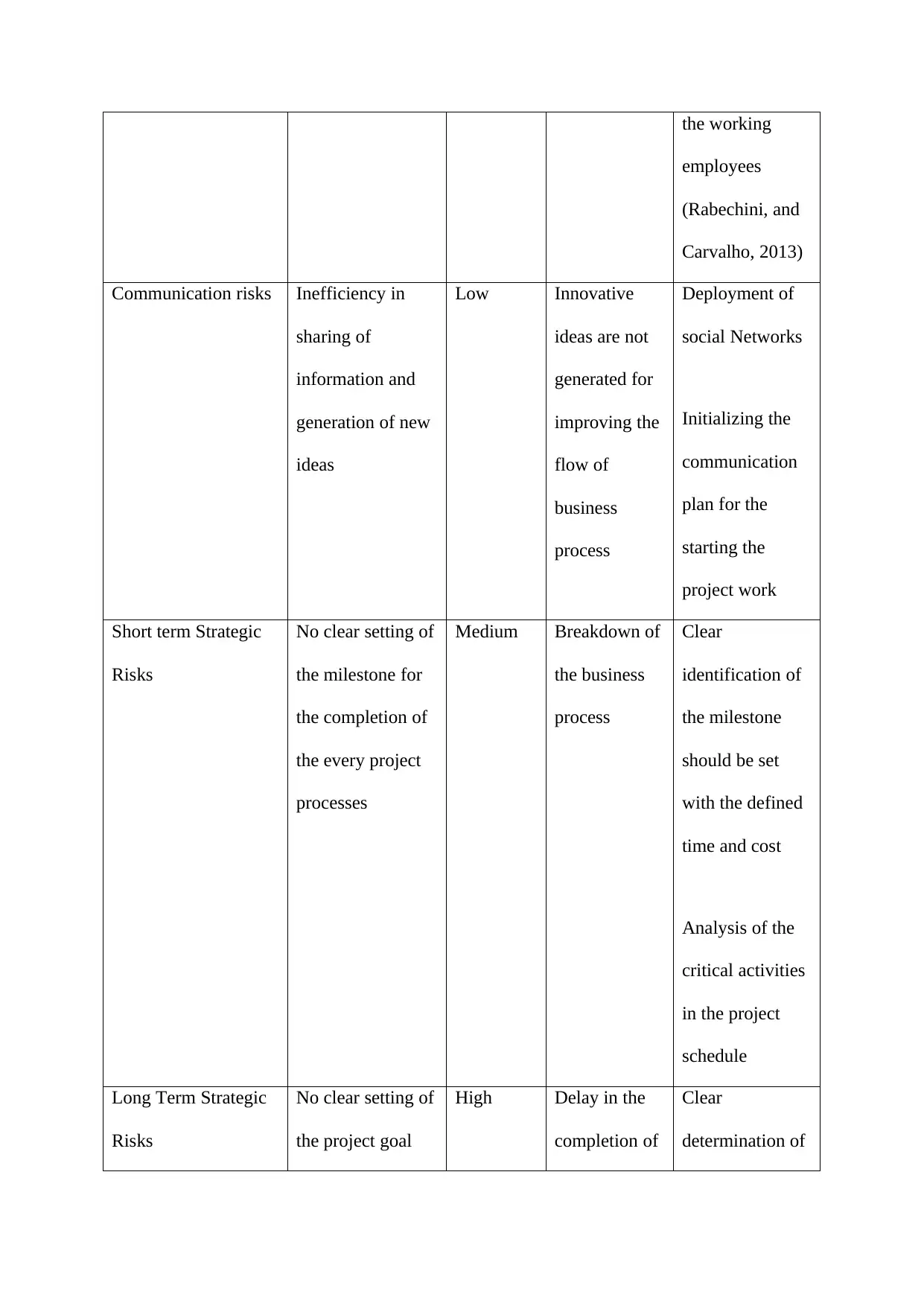
the working
employees
(Rabechini, and
Carvalho, 2013)
Communication risks Inefficiency in
sharing of
information and
generation of new
ideas
Low Innovative
ideas are not
generated for
improving the
flow of
business
process
Deployment of
social Networks
Initializing the
communication
plan for the
starting the
project work
Short term Strategic
Risks
No clear setting of
the milestone for
the completion of
the every project
processes
Medium Breakdown of
the business
process
Clear
identification of
the milestone
should be set
with the defined
time and cost
Analysis of the
critical activities
in the project
schedule
Long Term Strategic
Risks
No clear setting of
the project goal
High Delay in the
completion of
Clear
determination of
employees
(Rabechini, and
Carvalho, 2013)
Communication risks Inefficiency in
sharing of
information and
generation of new
ideas
Low Innovative
ideas are not
generated for
improving the
flow of
business
process
Deployment of
social Networks
Initializing the
communication
plan for the
starting the
project work
Short term Strategic
Risks
No clear setting of
the milestone for
the completion of
the every project
processes
Medium Breakdown of
the business
process
Clear
identification of
the milestone
should be set
with the defined
time and cost
Analysis of the
critical activities
in the project
schedule
Long Term Strategic
Risks
No clear setting of
the project goal
High Delay in the
completion of
Clear
determination of
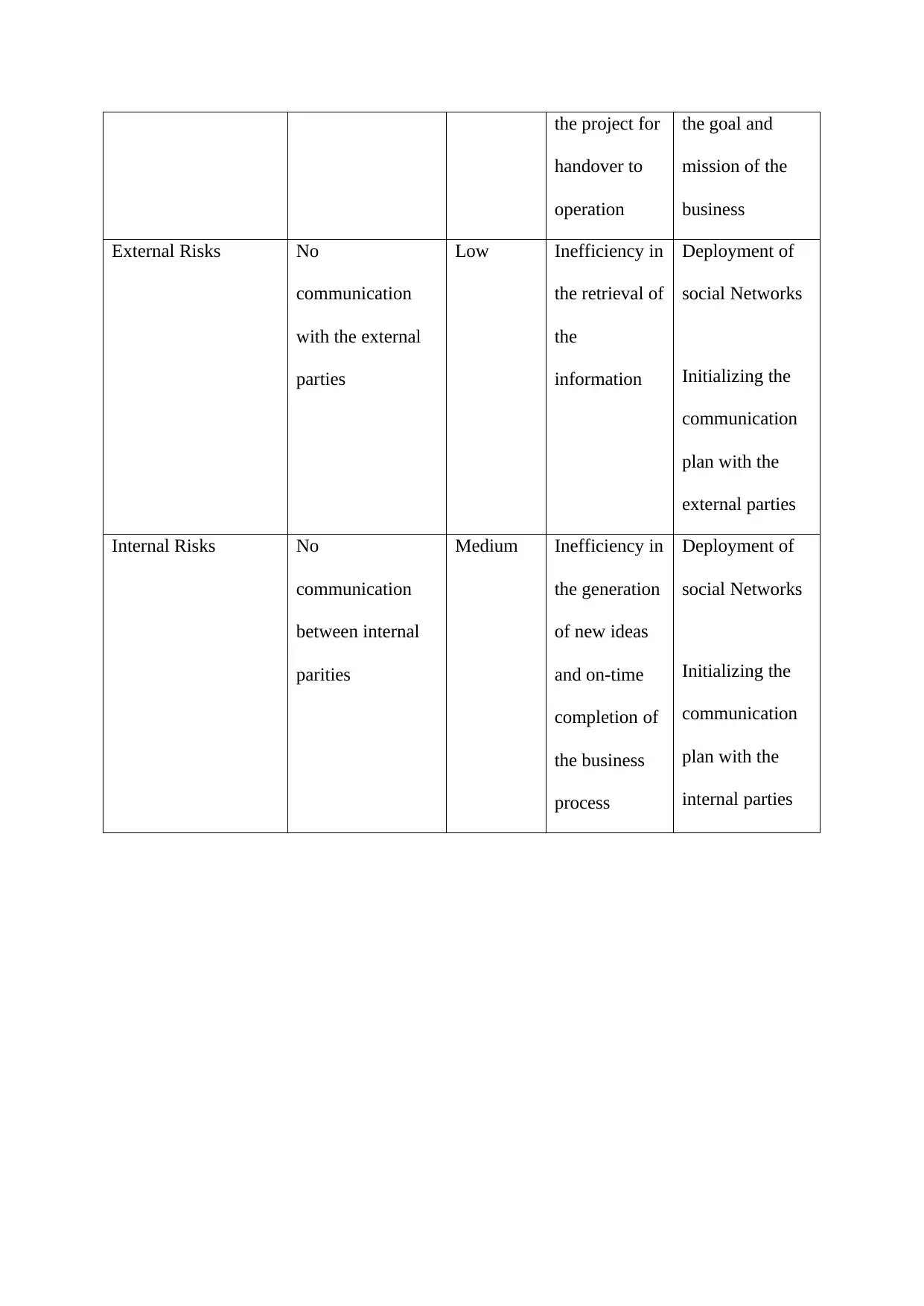
the project for
handover to
operation
the goal and
mission of the
business
External Risks No
communication
with the external
parties
Low Inefficiency in
the retrieval of
the
information
Deployment of
social Networks
Initializing the
communication
plan with the
external parties
Internal Risks No
communication
between internal
parities
Medium Inefficiency in
the generation
of new ideas
and on-time
completion of
the business
process
Deployment of
social Networks
Initializing the
communication
plan with the
internal parties
handover to
operation
the goal and
mission of the
business
External Risks No
communication
with the external
parties
Low Inefficiency in
the retrieval of
the
information
Deployment of
social Networks
Initializing the
communication
plan with the
external parties
Internal Risks No
communication
between internal
parities
Medium Inefficiency in
the generation
of new ideas
and on-time
completion of
the business
process
Deployment of
social Networks
Initializing the
communication
plan with the
internal parties
⊘ This is a preview!⊘
Do you want full access?
Subscribe today to unlock all pages.

Trusted by 1+ million students worldwide
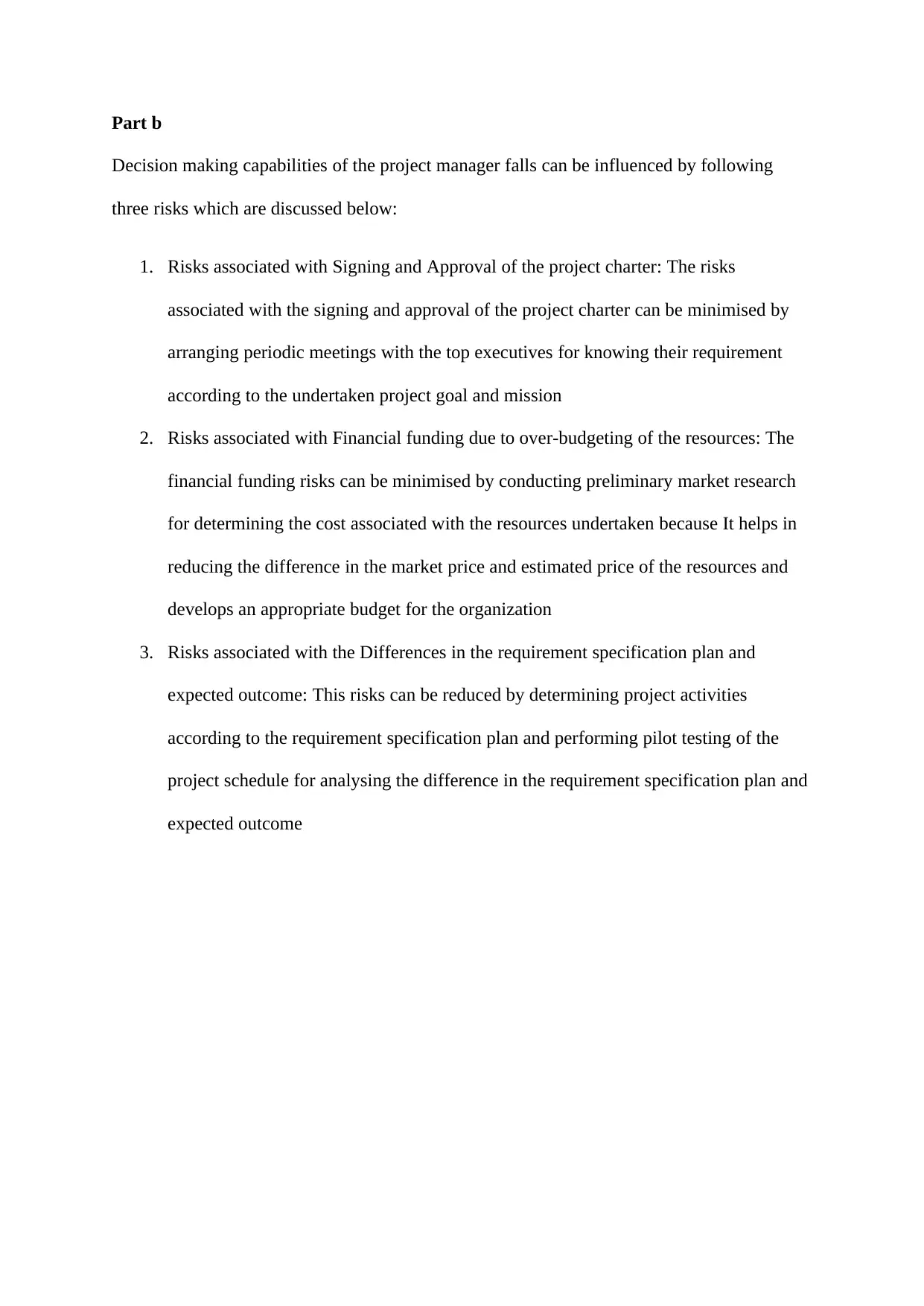
Part b
Decision making capabilities of the project manager falls can be influenced by following
three risks which are discussed below:
1. Risks associated with Signing and Approval of the project charter: The risks
associated with the signing and approval of the project charter can be minimised by
arranging periodic meetings with the top executives for knowing their requirement
according to the undertaken project goal and mission
2. Risks associated with Financial funding due to over-budgeting of the resources: The
financial funding risks can be minimised by conducting preliminary market research
for determining the cost associated with the resources undertaken because It helps in
reducing the difference in the market price and estimated price of the resources and
develops an appropriate budget for the organization
3. Risks associated with the Differences in the requirement specification plan and
expected outcome: This risks can be reduced by determining project activities
according to the requirement specification plan and performing pilot testing of the
project schedule for analysing the difference in the requirement specification plan and
expected outcome
Decision making capabilities of the project manager falls can be influenced by following
three risks which are discussed below:
1. Risks associated with Signing and Approval of the project charter: The risks
associated with the signing and approval of the project charter can be minimised by
arranging periodic meetings with the top executives for knowing their requirement
according to the undertaken project goal and mission
2. Risks associated with Financial funding due to over-budgeting of the resources: The
financial funding risks can be minimised by conducting preliminary market research
for determining the cost associated with the resources undertaken because It helps in
reducing the difference in the market price and estimated price of the resources and
develops an appropriate budget for the organization
3. Risks associated with the Differences in the requirement specification plan and
expected outcome: This risks can be reduced by determining project activities
according to the requirement specification plan and performing pilot testing of the
project schedule for analysing the difference in the requirement specification plan and
expected outcome
Paraphrase This Document
Need a fresh take? Get an instant paraphrase of this document with our AI Paraphraser
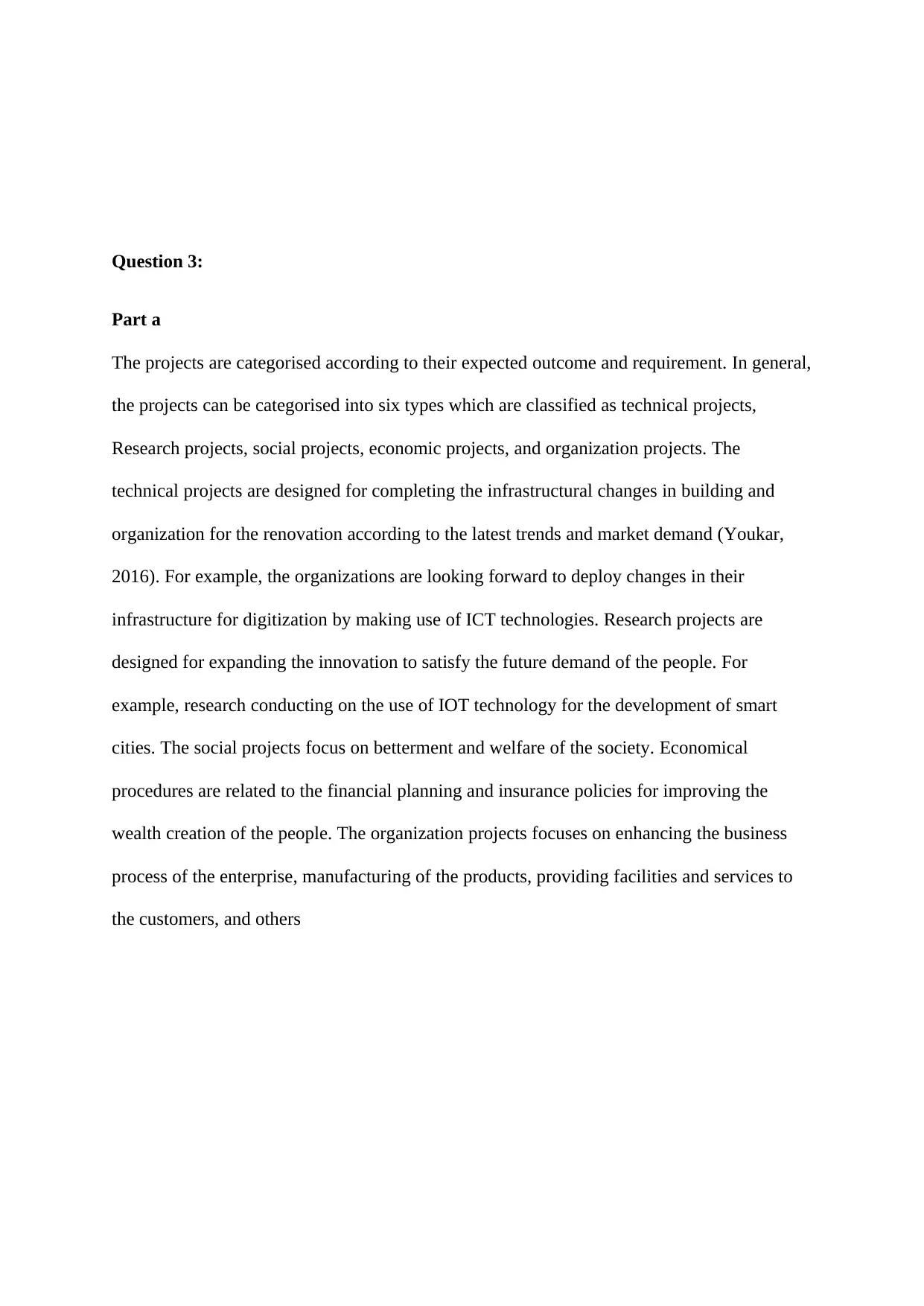
Question 3:
Part a
The projects are categorised according to their expected outcome and requirement. In general,
the projects can be categorised into six types which are classified as technical projects,
Research projects, social projects, economic projects, and organization projects. The
technical projects are designed for completing the infrastructural changes in building and
organization for the renovation according to the latest trends and market demand (Youkar,
2016). For example, the organizations are looking forward to deploy changes in their
infrastructure for digitization by making use of ICT technologies. Research projects are
designed for expanding the innovation to satisfy the future demand of the people. For
example, research conducting on the use of IOT technology for the development of smart
cities. The social projects focus on betterment and welfare of the society. Economical
procedures are related to the financial planning and insurance policies for improving the
wealth creation of the people. The organization projects focuses on enhancing the business
process of the enterprise, manufacturing of the products, providing facilities and services to
the customers, and others
Part a
The projects are categorised according to their expected outcome and requirement. In general,
the projects can be categorised into six types which are classified as technical projects,
Research projects, social projects, economic projects, and organization projects. The
technical projects are designed for completing the infrastructural changes in building and
organization for the renovation according to the latest trends and market demand (Youkar,
2016). For example, the organizations are looking forward to deploy changes in their
infrastructure for digitization by making use of ICT technologies. Research projects are
designed for expanding the innovation to satisfy the future demand of the people. For
example, research conducting on the use of IOT technology for the development of smart
cities. The social projects focus on betterment and welfare of the society. Economical
procedures are related to the financial planning and insurance policies for improving the
wealth creation of the people. The organization projects focuses on enhancing the business
process of the enterprise, manufacturing of the products, providing facilities and services to
the customers, and others
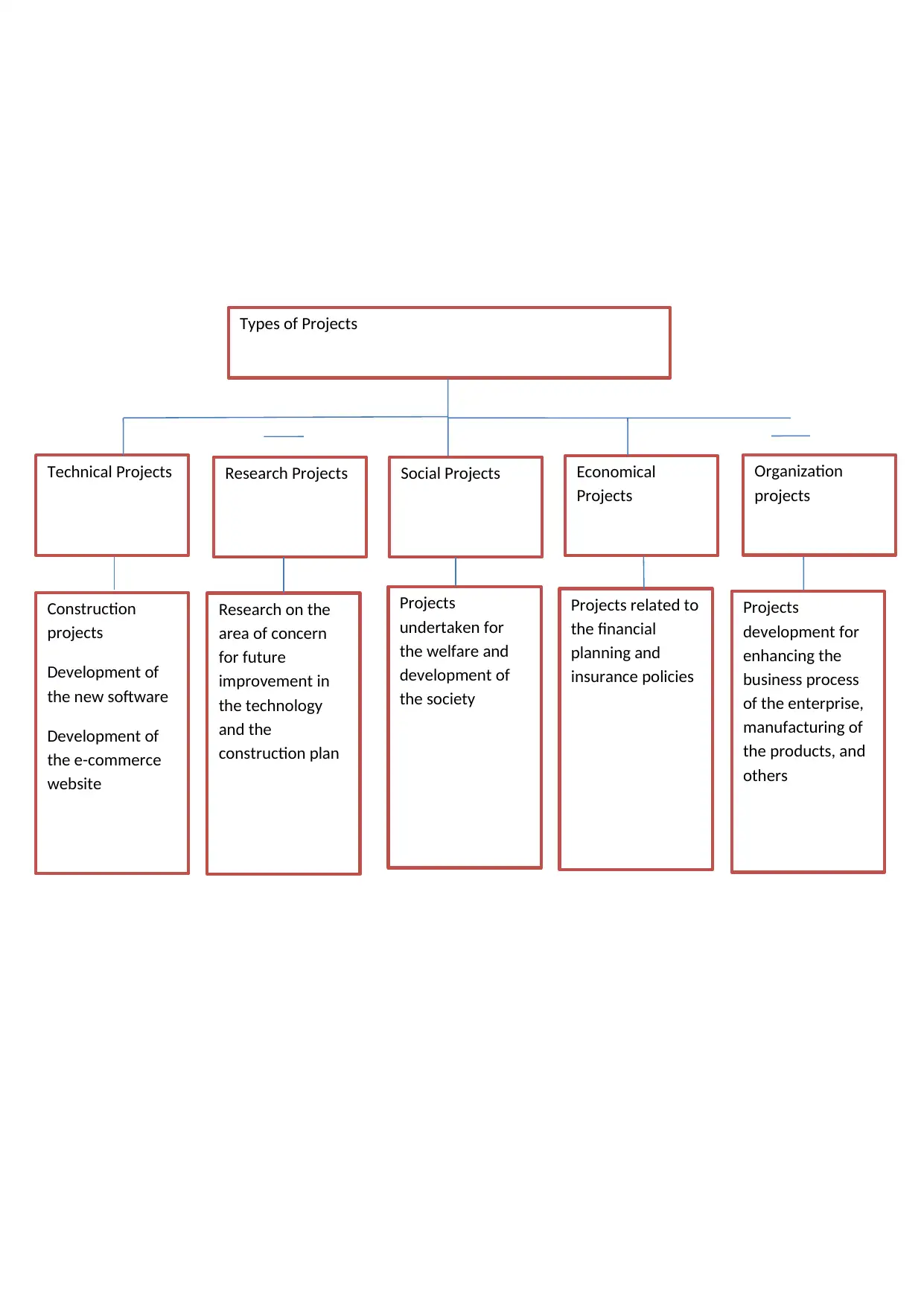
Types of Projects
Technical Projects Research Projects Social Projects Economical
Projects
Organization
projects
Construction
projects
Development of
the new software
Development of
the e-commerce
website
Research on the
area of concern
for future
improvement in
the technology
and the
construction plan
Projects
undertaken for
the welfare and
development of
the society
Projects related to
the financial
planning and
insurance policies
Projects
development for
enhancing the
business process
of the enterprise,
manufacturing of
the products, and
others
Technical Projects Research Projects Social Projects Economical
Projects
Organization
projects
Construction
projects
Development of
the new software
Development of
the e-commerce
website
Research on the
area of concern
for future
improvement in
the technology
and the
construction plan
Projects
undertaken for
the welfare and
development of
the society
Projects related to
the financial
planning and
insurance policies
Projects
development for
enhancing the
business process
of the enterprise,
manufacturing of
the products, and
others
⊘ This is a preview!⊘
Do you want full access?
Subscribe today to unlock all pages.

Trusted by 1+ million students worldwide
1 out of 22
Related Documents
Your All-in-One AI-Powered Toolkit for Academic Success.
+13062052269
info@desklib.com
Available 24*7 on WhatsApp / Email
![[object Object]](/_next/static/media/star-bottom.7253800d.svg)
Unlock your academic potential
Copyright © 2020–2025 A2Z Services. All Rights Reserved. Developed and managed by ZUCOL.





